A Low-Profile Dielectric Resonator Antenna Array for OAM Waves Generation at 5G NR Bands
Abstract
:1. Introduction
2. Design Methodology
3. Results and Discussion
3.1. Reflection Coefficient ()
3.2. Phase and Intensity Distributions
3.3. Radiation Pattern
3.4. Mode Purity
4. Conclusions
Author Contributions
Funding
Data Availability Statement
Acknowledgments
Conflicts of Interest
References
- Le, T.-K.; Salim, U.; Kaltenberger, F. An Overview of Physical Layer Design for Ultra-Reliable Low-Latency Communications in 3GPP Releases 15, 16, and 17. IEEE Access 2021, 9, 433–444. [Google Scholar] [CrossRef]
- Sim, C.-Y.-D.; Liu, H.-Y.; Huang, C.-J. Wideband MIMO Antenna Array Design for Future Mobile Devices Operating in the 5G NR Frequency Bands n77/n78/n79 and LTE Band 46. IEEE Antennas Wirel. Propag. Lett. 2020, 19, 74–78. [Google Scholar] [CrossRef]
- Ghosh, A.; Maeder, A.; Baker, M.; Chandramouli, D. 5G Evolution: A View on 5G Cellular Technology Beyond 3GPP Release 15. IEEE Access 2019, 7, 127639–127651. [Google Scholar] [CrossRef]
- Chettri, L.; Bera, R. A Comprehensive Survey on Internet of Things (IoT) Toward 5G Wireless Systems. IEEE Internet Things J. 2020, 7, 16–32. [Google Scholar] [CrossRef]
- Chen, R.; Zhou, H.; Moretti, M.; Wang, X.; Li, J. Orbital Angular Momentum Waves: Generation, Detection, and Emerging Applications. IEEE Commun. Surv. Tutor. 2020, 22, 840–868. [Google Scholar] [CrossRef]
- Morgenthaler, F.R. An overview of electromagnetic and spin angular momentum mechanical waves in ferrite media. Proc. IEEE 1988, 76, 138–150. [Google Scholar] [CrossRef]
- Kim, K.Y. Transverse spin angular momentum of airy beams. IEEE Photonics J. 2012, 4, 2333–2339. [Google Scholar]
- Tao, J.; Wu, L.; Yang, Y.; Liu, Z.; Qiu, Y.; Zheng, G.; Yu, S. Light Spin Angular Momentum Spatial Mode Converter Based on Dielectric Metasurface. J. Light. Technol. 2021, 39, 2438–2442. [Google Scholar] [CrossRef]
- Allen, L.; Beijersbergen, M.W.; Spreeuw, R.J.C.; Woerdman, J.P. Orbital angular momentum of light and the transformation of Laguerre—Gaussian laser modes. Phys. Rev. A 1992, 45, 8185–8189. [Google Scholar] [CrossRef]
- Song, X.; Ma, J.; Bai, Y.; Yao, Y.; Zheng, Z.; Gao, X.; Huang, S. Optical-Controlled Fast Switching of Radio Frequency Orbital Angular Momentum Beams with Different Mode and Radiation Direction. J. Light. Technol. 2022, 40, 640–646. [Google Scholar] [CrossRef]
- Huang, J.; Cao, Z.; Zhao, X.; Zhang, X.; Liu, Y.; Xiang, Y.; Gerini, G.; Koonen, A.M.J. Optical Generation/Detection of Broadband Microwave Orbital Angular Momentum Modes. J. Light. Technol. 2020, 38, 1202–1209. [Google Scholar] [CrossRef]
- Zhu, L.; Yao, H.; Wang, J.; Tian, Q.; Zhang, Q.; Hanzo, L. Channel Modeling for Orbital Angular Momentum Based Underwater Wireless Optical Systems. IEEE Trans. Veh. Technol. 2022, 71, 5880–5895. [Google Scholar] [CrossRef]
- Lei, R.; Li, S.; Yang, Y.; Liu, B.; Zhang, L. Generating orbital angular momentum based on circular antenna array with filtering characteristic. Int. J. RF Microw. Comput. Eng. 2021, 31, e22714. [Google Scholar] [CrossRef]
- Rjeb, A.; Fathallah, H.; Machhout, M. Multiplexing, Transmission and De-Multiplexing of OAM Modes through Specialty Fibers. In Multiplexing—Recent Advances and Novel Applications; IntechOpen: London, UK, 2022; Available online: https://www.intechopen.com/chapters/79832 (accessed on 26 March 2023).
- Chen, M.L.N.; Jiang, L.J.; Sha, W.E.I. Orbital Angular Momentum Generation and Detection by Geometric-Phase Based Metasurfaces. Appl. Sci. 2018, 8, 362. [Google Scholar] [CrossRef]
- Noor, S.K.; Yasin, M.N.M.; Ismail, A.M.; Osman, M.N.; Soh, P.J.; Ramli, N.; Rambe, A.H. A Review of Orbital Angular Momentum Vortex Waves for the Next Generation Wireless Communications. IEEE Access 2022, 10, 89465–89484. [Google Scholar] [CrossRef]
- Cheng, W.; Zhang, W.; Jing, H.; Gao, S.; Zhang, H. Orbital Angular Momentum for Wireless Communications. IEEE Wirel. Commun. 2019, 26, 100–107. [Google Scholar] [CrossRef]
- Cheng, W.; Zhang, H.; Liang, L.; Jing, H.; Li, Z. Orbital-Angular-Momentum Embedded Massive MIMO: Achieving Multiplicative Spectrum-Efficiency for Mmwave Communications. IEEE Access 2018, 6, 2732–2745. [Google Scholar] [CrossRef]
- Zhou, C.; Liao, X.; Wang, Y.; Liao, S.; Zhou, J.; Zhang, J. Capacity and Security Analysis of Multi-Mode Orbital Angular Momentum Communications. IEEE Access 2020, 8, 150955–150963. [Google Scholar] [CrossRef]
- Hui, X.; Zheng, S.; Hu, Y.; Xu, C.; Jin, X.; Chi, H.; Zhang, X. Ultralow Reflectivity Spiral Phase Plate for Generation of Millimeter-wave OAM Beam. IEEE Antennas Wirel. Propag. Lett. 2015, 14, 966–969. [Google Scholar] [CrossRef]
- Chen, Y.; Zheng, S.; Li, Y.; Hui, X.; Jin, X.; Chi, H.; Zhang, X. A Flat-Lensed Spiral Phase Plate Based on Phase-Shifting Surface for Generation of Millimeter-Wave OAM Beam. IEEE Antennas Wirel. Propag. Lett. 2016, 15, 1156–1158. [Google Scholar] [CrossRef]
- Wei, H.; Amrithanath, A.K.; Krishnaswamy, S. 3D Printing of Micro-Optic Spiral Phase Plates for the Generation of Optical Vortex Beams. IEEE Photonics Technol. Lett. 2019, 31, 599–602. [Google Scholar] [CrossRef]
- Nguyen, T.; Zenkyu, R.; Hirabe, M.; Maru, T.; Sasaki, E. A Study of Orbital Angular Momentum Generated by Parabolic Reflector with Circular Array Feed. Int. Symp. Antennas Propag. ISAP 2016, 2016, 708–709. [Google Scholar]
- Wu, Q.; Jiang, X.; Zhang, C. Attenuation of Orbital Angular Momentum Beam Transmission with a Parabolic Antenna. IEEE Antennas Wirel. Propag. Lett. 2021, 20, 1849–1853. [Google Scholar] [CrossRef]
- Yu, S.; Li, L.; Kou, N. Generation, reception and separation of mixed-state orbital angular momentum vortex beams using metasurfaces. Opt. Mater. Express 2017, 7, 3312–3321. [Google Scholar] [CrossRef]
- Wu, J.; Zhang, Z.; Ren, X.; Huang, Z.; Wu, X. A Broadband Electronically Mode-Reconfigurable Orbital Angular Momentum Metasurface Antenna. IEEE Antennas Wirel. Propag. Lett. 2019, 18, 1482–1486. [Google Scholar] [CrossRef]
- Guo, Z.-G.; Yang, G.-M. Radial Uniform Circular Antenna Array for Dual-Mode OAM Communication. IEEE Antennas Wirel. Propag. Lett. 2017, 16, 404–407. [Google Scholar] [CrossRef]
- Bi, K.; Xu, J.; Yang, D.; Hao, Y.; Gao, X.; Huang, S. Generation of Orbital Angular Momentum Beam with Circular Polarization Ceramic Antenna Array. IEEE Photonics J. 2019, 11, 1–8. [Google Scholar] [CrossRef]
- Liu, D.; Gui, L.; Zhang, Z.; Chen, H.; Song, G.; Jiang, T. Multiplexed OAM Wave Communication with Two-OAM-Mode Antenna Systems. IEEE Access 2019, 7, 4160–4166. [Google Scholar] [CrossRef]
- Bai, Q.; Tennant, A.; Cano, E.; Allen, B. An Experimental Phased Array for OAM Generation. Loughb. Antennas Propag. Conf. LAPC 2014, 2014, 165–168. [Google Scholar]
- Singh, S.; Upadhayay, M.D.; Pal, S. Study on Generation of Higher Order Orbital Angular Momentum Modes and Parameters Affecting the Vortex. Iran. J. Electr. Electron. Eng. 2021, 17, 1822. [Google Scholar] [CrossRef]
- Yu, Z.; Guo, N.; Fan, J. Water Spiral Dielectric Resonator Antenna for Generating Multimode OAM. IEEE Antennas Wirel. Propag. Lett. 2020, 19, 601–605. [Google Scholar] [CrossRef]
- Akram, M.R.; Gui, L.; Liu, D. OAM Radio Waves Generation using Dielectric Resonator Antenna Array. Asia Pac. Int. Symp. Electromagn. Compat. APEMC 2016, 2016, 591–593. [Google Scholar]
- Dhanade, Y.B.; Patnaik, K.M.; Yadav, V.S.; Patnaik, A. Mode Purity Analysis of an Orbital Angular Momentum Antenna. In Proceedings of the 2022 IEEE Microwaves, Antennas, and Propagation Conference (MAPCON), Bangalore, India, 12–16 December 2022; pp. 1341–1345. [Google Scholar] [CrossRef]
- Fang, L.; Henderson, R.M. Orbital Angular Momentum Uniform Circular Antenna Array Design and Optimization-Based Array Factor. In Proceedings of the 2019 IEEE Texas Symposium on Wireless and Microwave Circuits and Systems (WMCS), Waco, TX, USA, 28–29 March 2019; pp. 1–4. [Google Scholar] [CrossRef]
- Noor, S.K.; Ismail, A.M.; Yasin, N.; Yasin, M.; Osman, M.N.; Ramli, N.; Rambe, A.H.; Iqbal, J. Generation of OAM Waves and Analysis of Mode Purity for 5G Sub-6 GHz Applications. Comput. Mater. Contin. 2023, 74, 2239–2259. [Google Scholar]

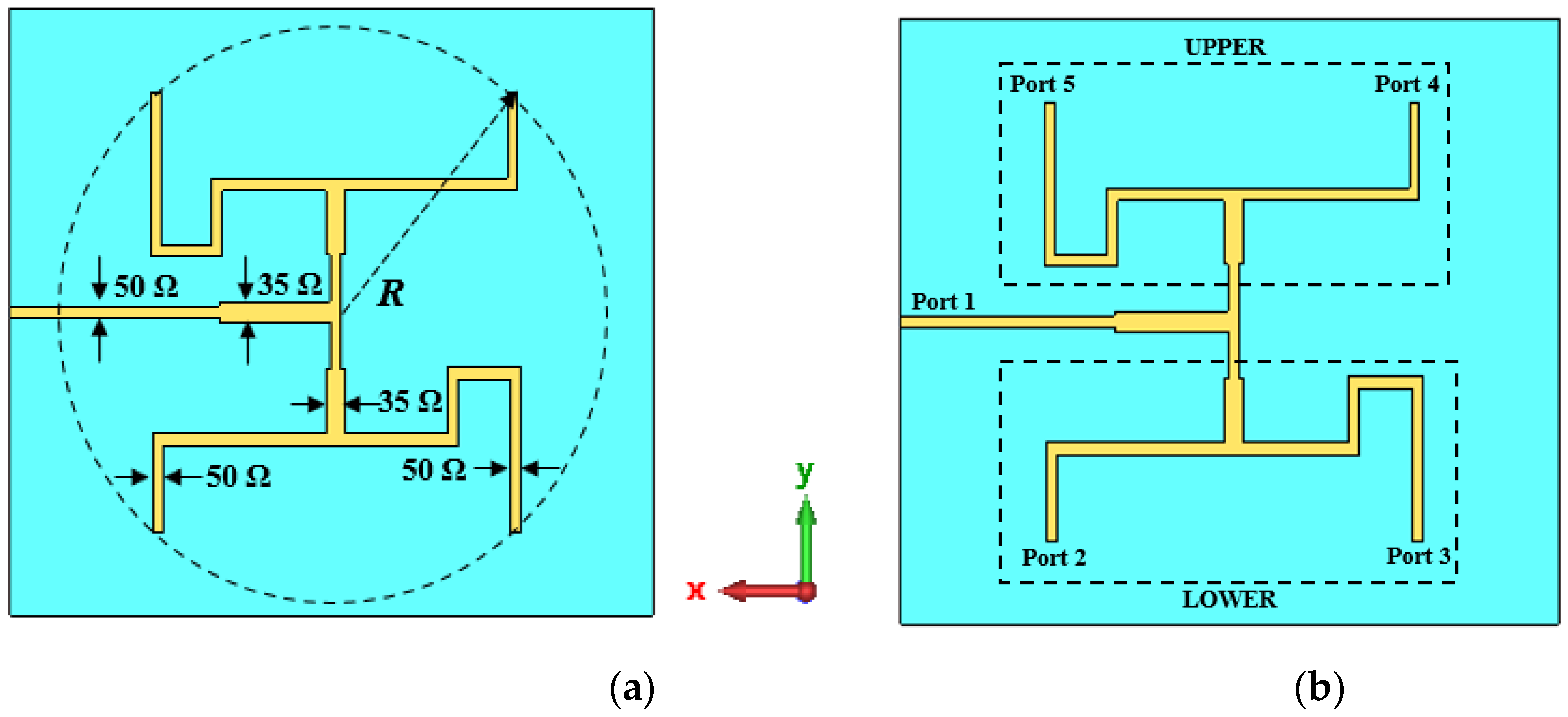
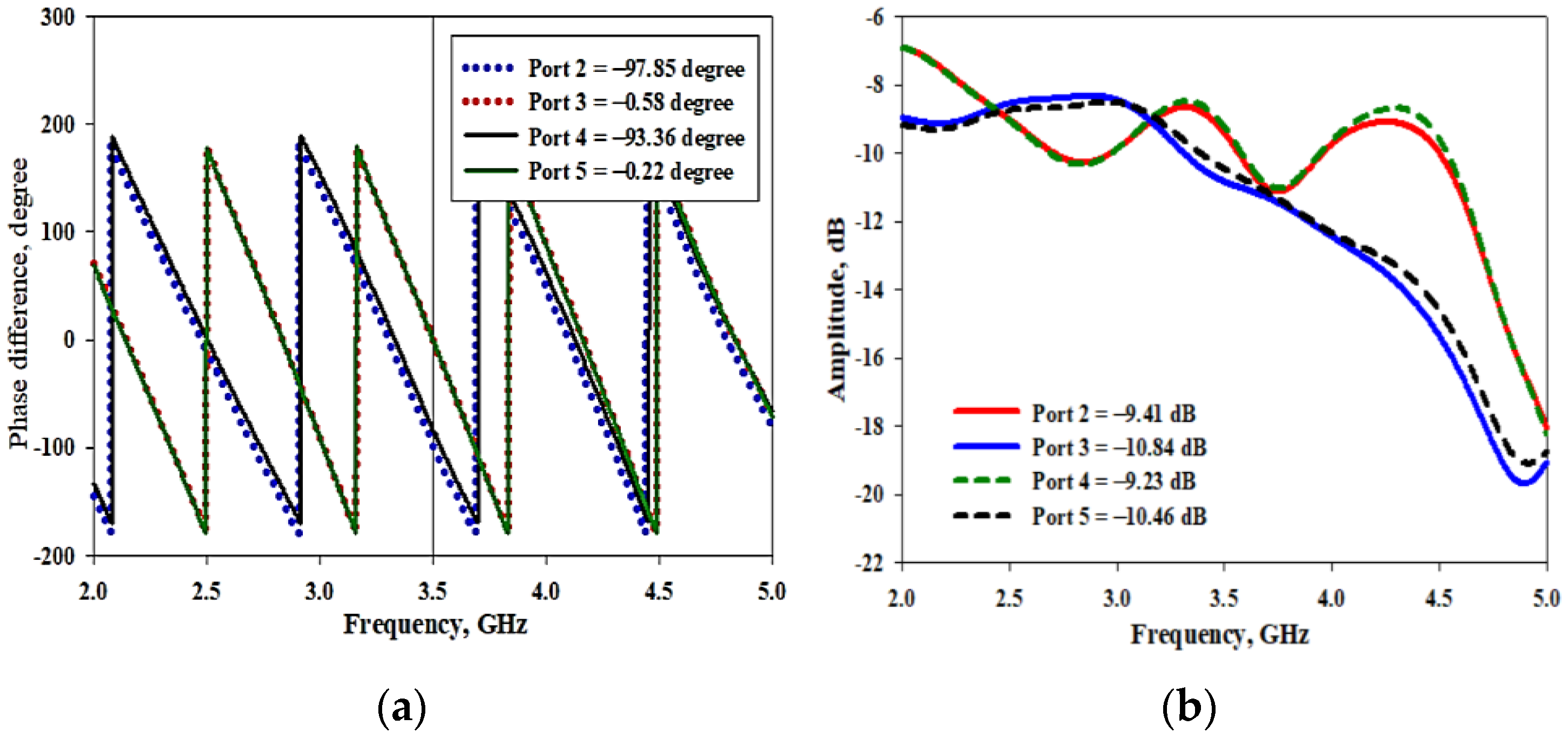
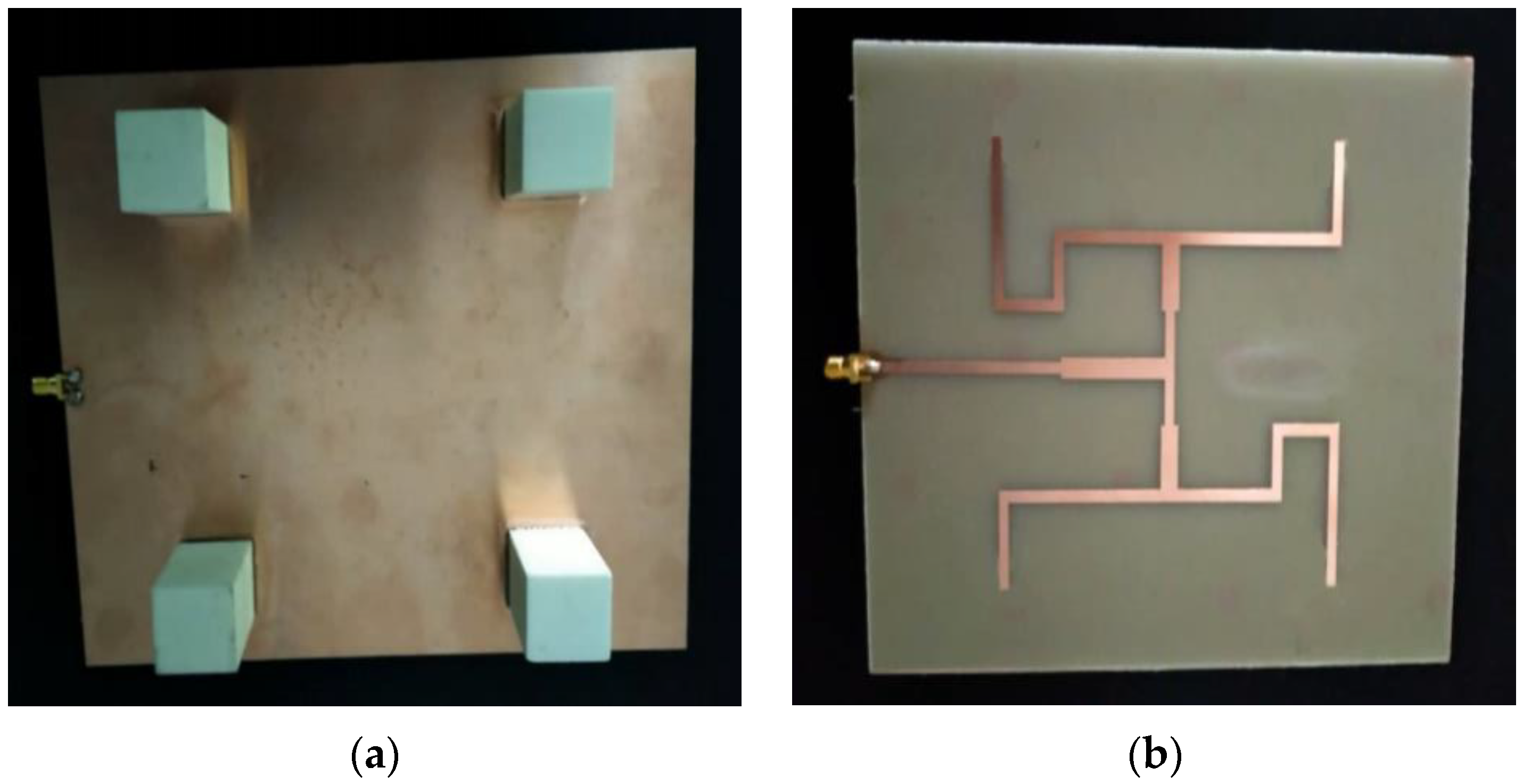

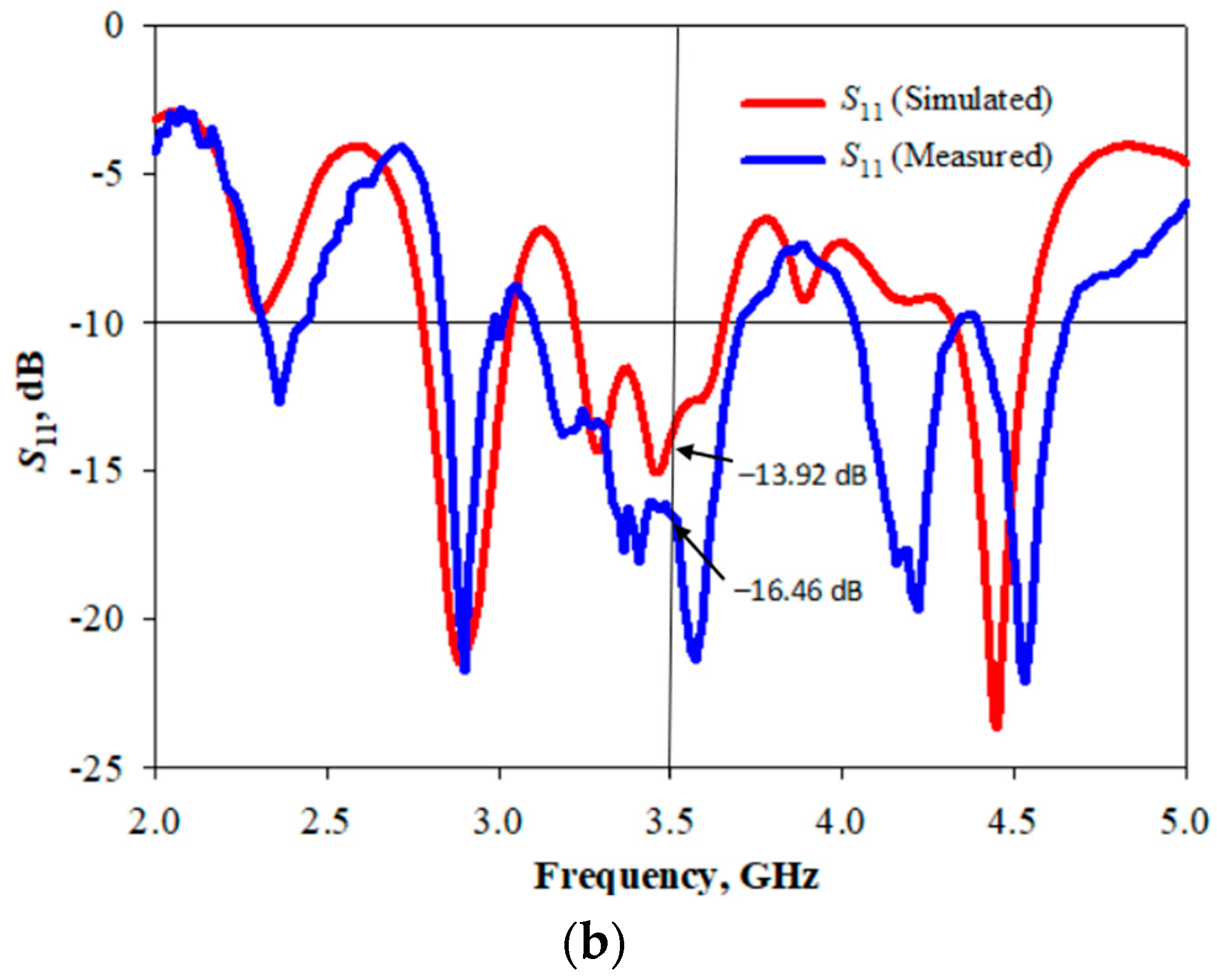
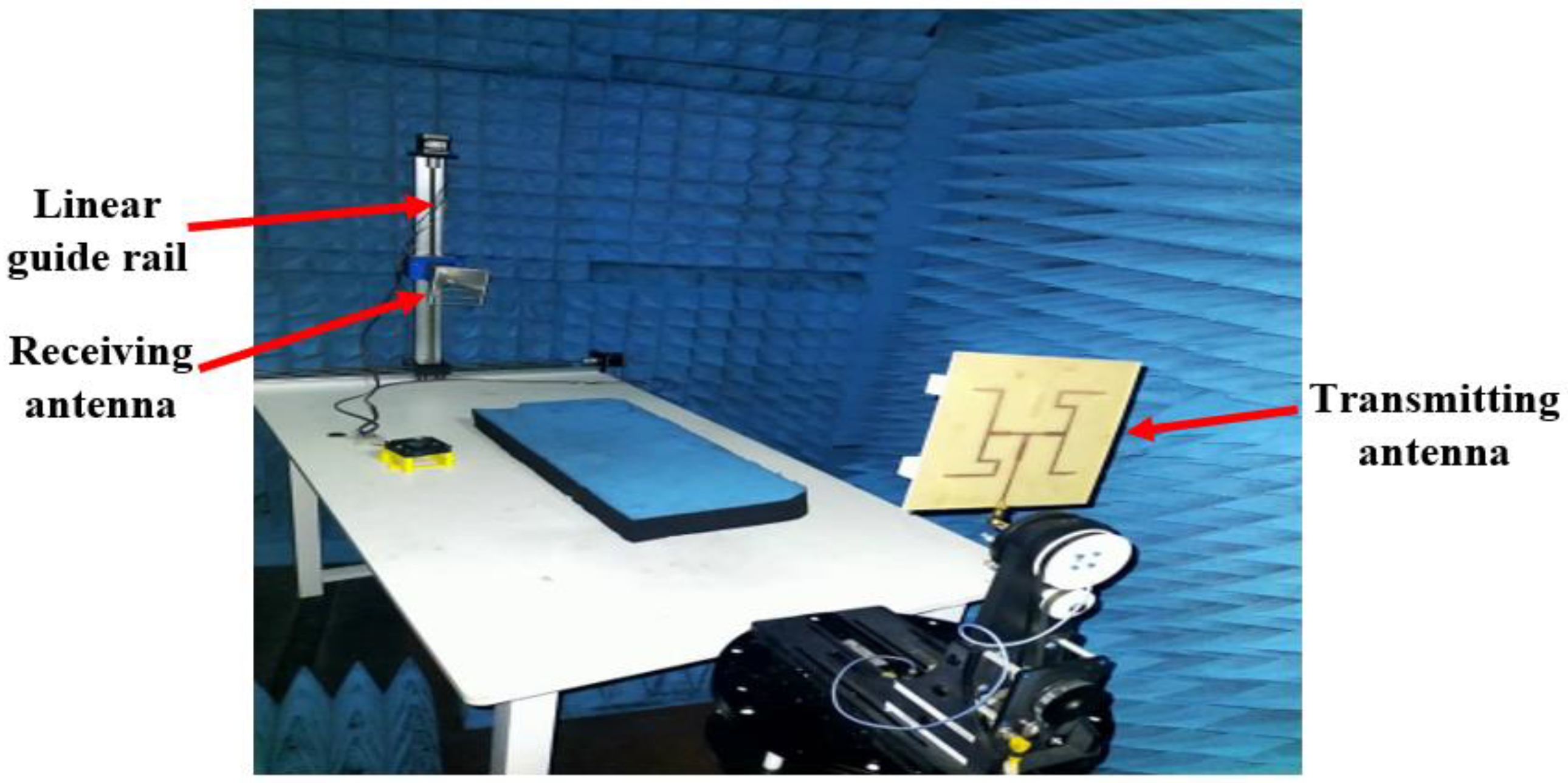

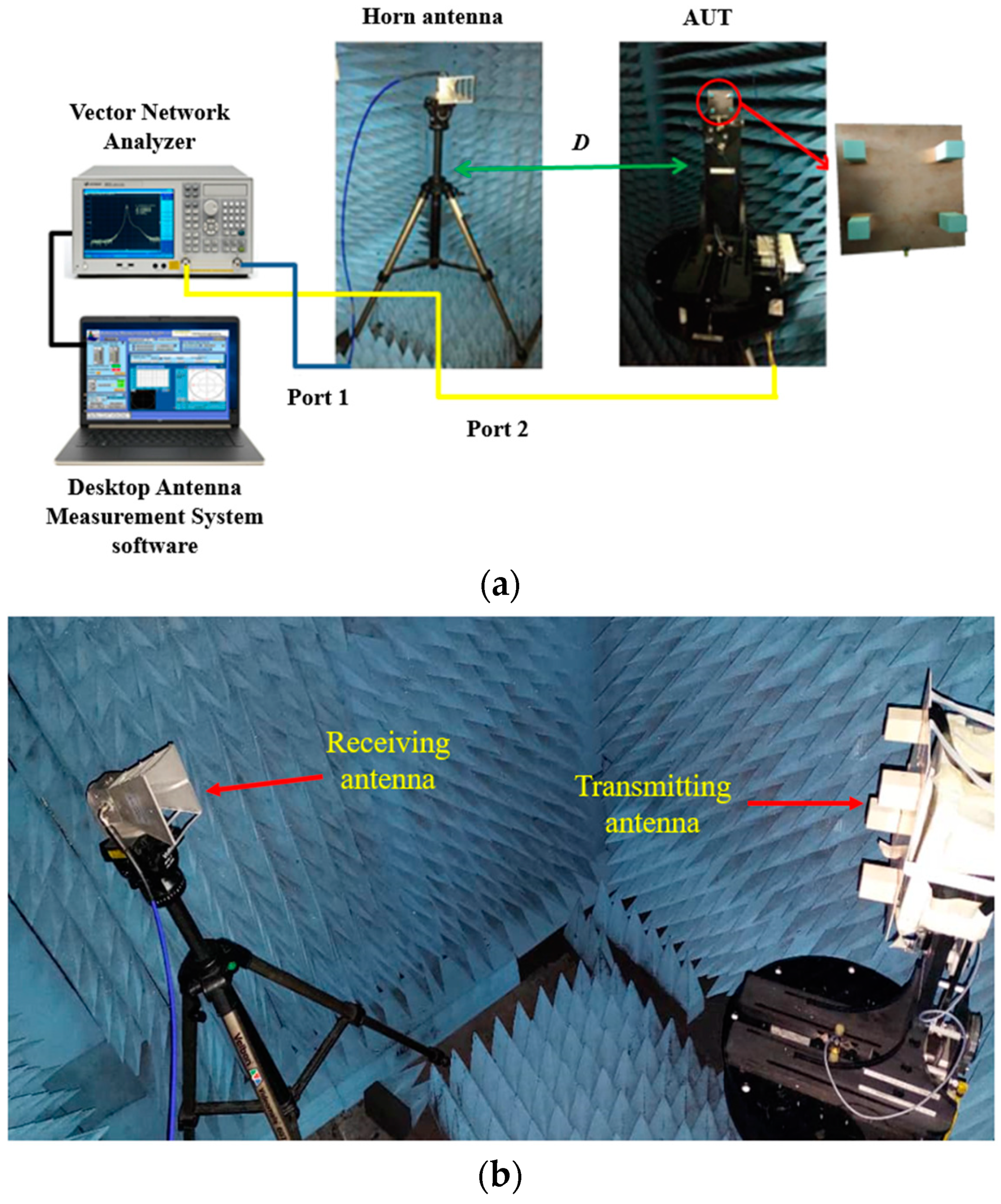
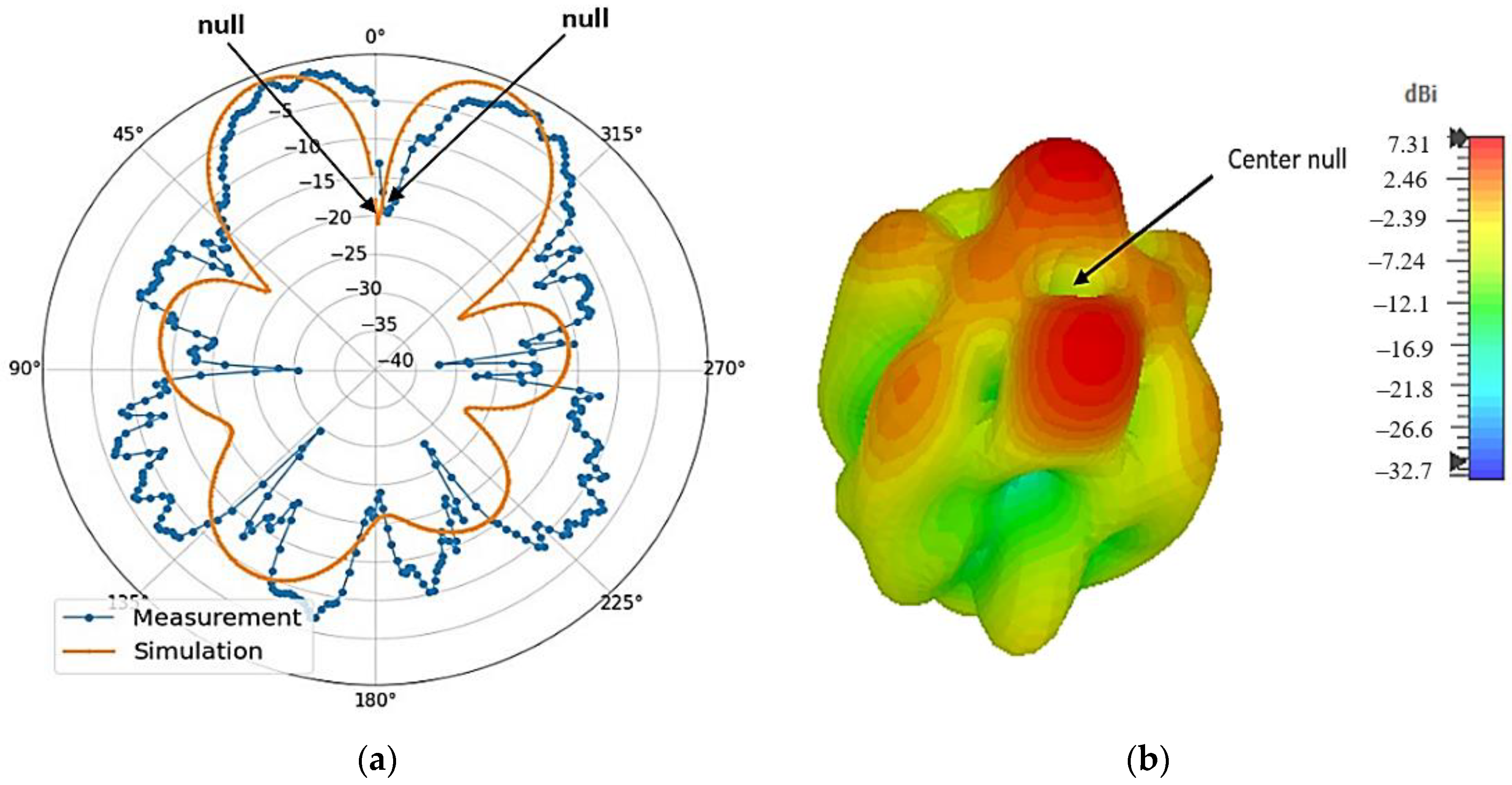

| Parameters | Values (mm) | Parameters | Values (mm) | Parameters | Values (mm) |
|---|---|---|---|---|---|
| 160 | 22 | 36 | |||
| 185 | 32 | 1.5 | |||
| 22 | h | 1.6 | R | 77 |
| Ref. | fr (GHz) | Imp. BW (%) | Antenna Dimension | Gain (dBi) | Mode Number | Mode Purity (%) | Measurement of Phase and Intensity Distributions |
|---|---|---|---|---|---|---|---|
| [25] | 4.5–7 | 43.5 | 5.83λ × 5.83λ | NA | +1 and +2 | NA | Yes |
| [26] | 4.9–6.5 | 28.1 | 1.4λ × 1.4λ | 15.19 | 0 and ±1 | NA | Yes (Phase only) |
| [27] | 5.72–5.95 | 3.94 | R = 1.46λ | NA | ±1 | NA | Yes (Phase only) |
| [28] | 1.54–1.56 | 1.29 | NA | NA | ±1 | NA | No |
| [29] | 2.25–2.4 | 6.45 | 3.5λ × 3.5λ | NA | +1 and +2 | NA | Yes (Phase only) |
| [30] | 10.2–10.7 | 4.78 | NA | 4.6 | −1 | NA | No |
| [31] | 9.25–10.5 | 12.66 | R = 0.19λ | NA | +1 | NA | Yes (Phase only) |
| [32] | 5.07–5.14 | 1.37 | R = 0.37λ | 1.08 | ±1 and ±3 | NA | Yes (Phase only) |
| [33] | 2.8–4.55 | 47.6 | NA | NA | +1 and +2 | NA | No |
| This work | 3.2–3.66 | 13.4 | 2.16λ × 1.87λ | 7.3 | +1 | 53.87 | Yes |
Disclaimer/Publisher’s Note: The statements, opinions and data contained in all publications are solely those of the individual author(s) and contributor(s) and not of MDPI and/or the editor(s). MDPI and/or the editor(s) disclaim responsibility for any injury to people or property resulting from any ideas, methods, instructions or products referred to in the content. |
© 2023 by the authors. Licensee MDPI, Basel, Switzerland. This article is an open access article distributed under the terms and conditions of the Creative Commons Attribution (CC BY) license (https://creativecommons.org/licenses/by/4.0/).
Share and Cite
Abd Rahman, N.A.; Noor, S.K.; Ibrahim, I.M.; Yasin, M.N.M.; Ismail, A.M.; Osman, M.N.; Ismail, S.B. A Low-Profile Dielectric Resonator Antenna Array for OAM Waves Generation at 5G NR Bands. Micromachines 2023, 14, 841. https://doi.org/10.3390/mi14040841
Abd Rahman NA, Noor SK, Ibrahim IM, Yasin MNM, Ismail AM, Osman MN, Ismail SB. A Low-Profile Dielectric Resonator Antenna Array for OAM Waves Generation at 5G NR Bands. Micromachines. 2023; 14(4):841. https://doi.org/10.3390/mi14040841
Chicago/Turabian StyleAbd Rahman, Nur Akmal, Shehab Khan Noor, Imran Mohd Ibrahim, Mohd Najib Mohd Yasin, Arif Mawardi Ismail, Mohamed Nasrun Osman, and Shaiful Bakri Ismail. 2023. "A Low-Profile Dielectric Resonator Antenna Array for OAM Waves Generation at 5G NR Bands" Micromachines 14, no. 4: 841. https://doi.org/10.3390/mi14040841





